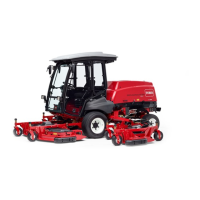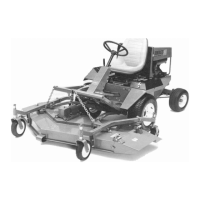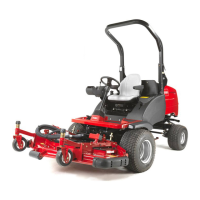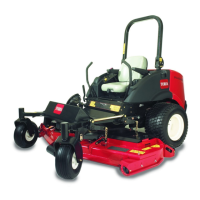3. Examine the cutting edges of all the blades. Sharpen
the cutting edges that are dull or nicked. To assure
sharpness, sharpen only the top side of the cutting
edge while maintaining the original cutting angle
(Fig. 61). If the same amount of metal is removed
from both cutting edges, the blade will remain
balanced.
Figure 61
1. Sharpen at original angle
2. End view
4. To check the blade for being straight and parallel,
remove from cutting unit. Lay the blade on level
surface and check its ends. Blade ends must be
slightly lower than the blade center and cutting edge
lower than the heel of the blade. If so, it will
produce good quality of cut and require minimal
engine power to turn. By contrast, a blade with ends
higher than the blade center, or with the cutting
edge higher than the blade heel, is warped or bent
and must be replaced.
5. When re-assembling, make sure the blade sail is
facing up. Torque the blade bolt to 140-165 ft.- lb.
INSPECTING AND ADJUSTING
CUTTING UNIT BELT TENSION
IMPORTANT: After first ten hours of operation, check
new belts for proper tension; thereafter, check tension
every 50 hours.
Front Cutting Unit
Note: Belts for wing unit spindles are tensioned by spring
loaded idlers and normally do not require tensioning.
1. Position the machine on level surface, lower the
cutting unit to the shop floor, engage the parking
brake, shut the engine off and remove the key from
the ignition switch.
Figure 62
1. Compression spring and tension plate
2. Wing unit drive belt
3. Gear box plate
4. Center drive belt
5. Lift arm
2. Note position of shoulder bolts in slots in tension
plate. Optimum belt tension will be maintained
when the flanges on the shoulder bolts are 3 mm
from the pulley ends of the slots (Fig. 63). If the
shoulder bolt flanges are more than 9 mm from the
pulley end of the slots, an adjustment should be
made.
Figure 63
1. Tension plate
2. Shoulder bolts
3. To adjust, loosen the jam nuts (Fig. 64) and extend
the tension arm until the shoulder bolt flanges are
within 3 mm of the pulley end of the slots (Fig. 63).
Note: When the shoulder bolt flanges are positioned 3 mm
from the pulley end of the slots, the length of the
Maintenance
42
If the blade is allowed to wear, a slot will form
between the sail and flat part of the blade (Fig.
60C)). Part of the blade may eventually break off
and be thrown from under the housing, possibly
resulting in serious injury to yourself or bystanders.
CAUTION
1
2
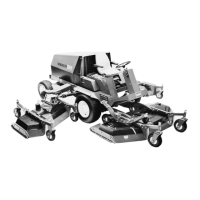
